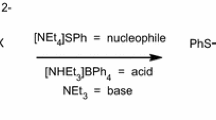Abstract
The analogy of chloride–chloride contacts in compounds containing Fe–Cl1···Cl2–Fe synthons with well-studied organic C–Cl1···Cl2–C interactions has been investigated. The crystal structures of the two tetrahaloferrate(III) salts, [(2-iodopyridinium)2FeX4]X (X = Cl, Br) have been determined. Analysis of these two isomorphous structures and related published structures shows that the arrangement of Fe–Cl1···Cl2–Fe synthons is similar to that of C–Cl1···Cl2–C with the Fe–Cl1···Cl2 and Cl1···Cl2–Fe angles being ~150°. While inter-chlorine distances are less than the sum of van der Waals radii in C–Cl1···Cl2–C units, they are equal to, or longer, than the sum of van der Waals radii in the corresponding Fe–Cl1···Cl2–Fe contacts. This might indicate that the arrangement of Fe–Cl1···Cl2–Fe synthons occurs predominately to reduce repulsive forces rather than as a result of attractive forces. However, it is observed that the halide–halide distance in [(2-iodopyridinium)2FeBr4]Br is shorter than in the isostructural chloride species, which can be explained by the fact that bromine is softer than chlorine. Several intermolecular forces unite the cations and anions within the crystalline lattice of [(2-iodopyridinium)2FeX4]X including N–H···X−, C–I···X–Fe, N(π)···X–Fe, N(π)···I–C, and Fe–X1···X2–Fe contacts. The calculated electron density and electrostatic potential of the [FeX4]− anions and the organic iodopyridinium cations was used to describe the arrangement of these synthons and the hierarchy of the strengths of the respective contacts.








Similar content being viewed by others
References
Aakeröy CB, Champness NR, Janiak C (2010) CrystEngComm 12:22
Awwadi FF, Willett RD, Peterson KA, Twamley B (2006) Chem Eur J 12:8952
Brammer L, Zordan F, Espallargas GM, Purver SL, Marin LA, Adams H (2004) ACA Trans 39:114
Brisdon AK (2007) Annu Rep Prog Chem, Sect A 103:126
Desiraju GR, Parthasarathy R (1989) J Am Chem Soc 111:8725
Fourmigue M (2009) Curr Opin Solid State Mater Sci 13:36
Lommerse JP, Stone AJ, Taylor R, Allen FH (1996) J Am Chem Soc 118:3108
Metrangolo P, Neukirch H, Pilati T, Resnati G (2005) Acc Chem Res 38:386
Metrangolo P, Resnati G (eds) (2008) Halogen bonding fundamentals and applications, vol 126. Structure and bonding. Springer, Heidelberg
Fourmigue M (ed) (2008) Halogen bonding fundamentals and applications, vol 126. Structure and bonding. Springer, Berlin
Butcher RTN, Juan J, Ribas-Arino J, Sandvik AW, Turnbull MM, Landee CP, Wells BM, Awwadi FF (2009) Chem Commun 11: 1359
Schlueter JA, Park H, Halder GJ, Armand WR, Dunmars C, Chapman KW, Manson JL, Singleton J, McDonald R, Plonczak A, Kang J, Lee C, Whangbo M-H, Lancaster T, Steele AJ, Franke I, Wright JD, Blundell SJ, Pratt FL, de George J, Turnbull MM, Landee CP (2012) Inorg Chem 51:2121
Willett RD, Awwadi FF, Butcher R, Haddad SF, Twamley B (2003) Cryst Growth Des 3:301
Zordan F, Espallargas GM, Brammer L (2006) CrystEngComm 8:425
Ormond-Prout JE, Smart P, Brammer L (2012) Cryst Growth Des 12(1):205
Freytag M, Jones PG, Ahrens B, Fischer AK (1999) New J Chem 23:1137
Price SL, Stones AJ, Lusca J, Rowland RS, Thornley AE (1994) J Am Chem Soc 116:4910
Jagarlapudi AR, Sarma P, Desiraju GR (1986) Acc Chem Res 19:222
Espallargas GM, Brammer L, Allan DR, Pulham CR, Robertson N, Warren JE (2008) J Am Chem Soc 130:9058
Kobayashi H, Tomita H, Naito T, Kobayashi A, Sakai F, Watanabe T, Cassoux P (1996) J Am Chem Soc 118:368
Awwadi FF, Willett RD, Twamley B (2007) Cryst Growth Des 7:624
Zordan F, Purver SL, Adams H, Brammer L (2005) CrystEngComm 7:350
Bosch E, Barnes CL (2002) Cryst Growth Des 2:299
Rosokha SV, Neretin IS, Rosokha TY, Hecht J, Kochi Jk (2006) Heteroatom Chem 17:449
Awwadi FF, Haddad SF, Willett RD, Twamley B (2010) Cryst Growth Des 10:158
Ovens JS, Truong KN, Leznoff DB (2012) Dalton Trans 41(4):1345
Sheldrick GM (1997) Program for crystal structure refinement, vol SHELXL-97. University of Göttingen, Göttingen
Bondi A (1964) J Phys Chem A 68:441
Awwadi FF, Willett RD, Peterson K, Twamley B (2007) J Phys Chem A 111:2319
Awwadi FF, Willett RD, Twamley B (2009) J Mol Struct 918(1–3):116
Adams CJ, Colquhoun HM, Crawford PC, Lusi M, Orpen AG (2007) AngewChem, IntEd 46:1124
Frisch MJ, Trucks GW, Schlegel HB, Scuseri GE, Robb MA, Cheeseman JR, Montgomery JA, Vreven T, Kudin KN, Burant JC, Millam JM, Iyengar SS, Tomasi J, Barone V, Mennucci B, Cossi M, Scalmani G, Rega N, Petersson GA, Nakatsuji H, Hada M, Ehara M, Toyota K, Fukuda R, Hasegawa J, Ishida M, Nakajima T, Honda Y, Kitao O, Nakai H, Klene M, Li X, Knox JE, Hratchian HP, Cross JB, Adamo C, Jaramillo J, Gomperts R, Stratmann RE, Yazyev O, Austin AJ, Cammi R, Pomelli C, Ochterski JW, Ayala PY, Morokuma K, Voth GA, Salvador P, Dannenberg JJ, Zakrzewski VG, Dapprich S, Daniels AD, Strain MC, Farkas OD, Malick K, Rabuck AD, Raghavachari K, Foresman JB, Ortiz JV, Cui Q, Baboul AG, Clifford S, Cioslowski J, Stefanov BB, Liu G, iashenko A, Piskorz P, Komaromi I, Martin RL, Fox DJ, Keith T, Al-Laham MA, Peng CY, Nanayakkara A, Challacombe M, Gill PMW, Johnson B, Chen W, Wong MW, Gonzalez C, Pople JA (2003) Gaussian 03, revision D.01. Gaussian, Inc., Pittsburgh, PA
Author information
Authors and Affiliations
Corresponding author
Rights and permissions
About this article
Cite this article
Awwadi, F.F., Taher, D., Maabreh, A. et al. The role of Fe–X···X–Fe contacts in the crystal structures of [(2-iodopyridinium)2FeX4]X (X = Cl, Br). Struct Chem 24, 401–408 (2013). https://doi.org/10.1007/s11224-012-0090-3
Received:
Accepted:
Published:
Issue Date:
DOI: https://doi.org/10.1007/s11224-012-0090-3




